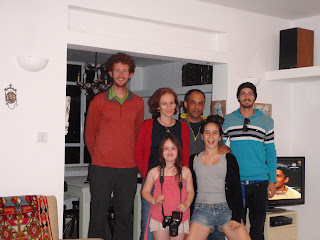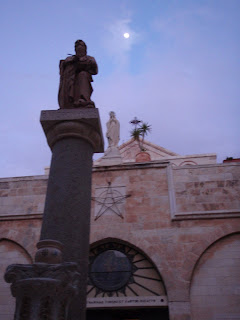As some of you may already know, a principal goal for our three week extension of this trip was to create a biogas digester for the cave-dwelling bedouin community of Ghwein, in the Southern Hebron Governate. Earlier in the abroad, we had spent a day with this community learning about their lifestyle, eating wonderful food, and hearing about the difficulties of living traditionally under the occupation. This day prompted our desire to give back. That same day, we briefly visited another small community, Suseya, where Adrian had helped Yair Teller to install a biogas digester a few weeks earlier. This project gave us the idea of spreading this proven system to the people of Ghwein. We have been spending some time setting up all the contacts, primarily with the biogas wizard Yair Teller, and our Hebron contact Nayef Hashlamoun. Through our work with these two individuals, we hope to see this project come to fruition.
After a week of emails and phone conversations, we set a tentative schedule for our project. Tuesday we were to travel to Ghwein, joined by Nayef as our local contact and translator to the cave dweller community. Nayef Hashlamoun is a retired photojournalist who worked for Reuters for many years. He now runs a small organic farm on his property, and is the full-time president of the Alwatan Center; a community center in downtown Hebron. Yair Teller is a graduate of the Arava Institute in southern Israel, which specializes in environmental issues, and is the only campus which has Israeli, Palestinian, Jordanian, and International students. After graduation, Yair started the small company Ecogas to provide biogas digesters to communities in the West Bank. Through email, Yair provided us with a list of supplies needed to create the biogas digesters, and we planned to collect these materials on Wednesday in Hebron with Nayef's help. Thursday will be spent building the biodigester with Nayef and Yair's help.
Tuesday started slow and rainy. Difficulties at the rental car agency and with directions meant that we arrived to Hebron in the early afternoon. We met up with Nayef at the Alwatan Center downtown and followed him to his house to visit the organic farm and discuss our exploratory trip to Ghwein. After the obligatory chai, we set out in the afternoon light, grateful that the rain had lifted. We spent the drive to Ghwein questioning Nayef about the possibilities of this project and learned that he had two site recommendations for implementation. The first site, slightly up the road from Ghwein was a small family farm and Women's community center. The second, a family of 13 within Ghwein itself. The next 4 hours, we spent trying to deliberate the most effective site to implement this system. It was not easy. Though we ended up content with our decision, Adrian and I had difficulty choosing between these two sites because this system would be excellent for both sites.
 |
| who could begrudge empathy and aid to children like this? |
We visited the women's center first and established that this site would be perfect for a biogas digester system. We were so content with this decision, we almost decided to move ahead with the project there without even visiting the other community. This site was perfect! We were confident that the project would take root and spread with an abundance of the needed inputs, a need for the gas and fertilizer, and willing participants. We elected to scope the other site just to be sure. The need for aid was felt very strongly in the second community. After a short while we began feeling uneasy This second family could barely afford to buy gas and certainly had an abundance of manure and wastewater, but due to the more arid conditions there seemed to be no agriculture. With the output of excellent fertilizer seemingly going unused, we were hesitant to subscribe to the biogas digester as the answer to their needs. We slowly learned that the family did have plans for a vegetable patch and herb garden for their personal use in the near future, and the sludgy fertilizer which flows from a biodigester would fit this project excellently.
 |
| members from the two different families survey a biogas digester in Suseya. |
After many hours of conversation and too many cups of tea to count, we headed home to Bethlehem still deliberating where to implement our project.
Tune in next time for the exciting conclusion to... The Alchemists!

















































